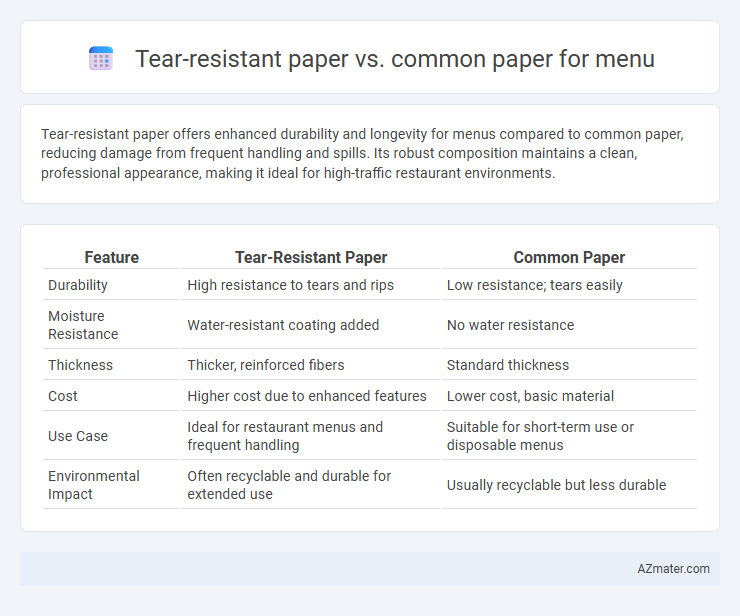Tear-resistant paper offers enhanced durability and longevity for menus compared to common paper, reducing damage from frequent handling and spills. Its robust composition maintains a clean, professional appearance, making it ideal for high-traffic restaurant environments.
Table of Comparison
| Feature | Tear-Resistant Paper | Common Paper |
|---|---|---|
| Durability | High resistance to tears and rips | Low resistance; tears easily |
| Moisture Resistance | Water-resistant coating added | No water resistance |
| Thickness | Thicker, reinforced fibers | Standard thickness |
| Cost | Higher cost due to enhanced features | Lower cost, basic material |
| Use Case | Ideal for restaurant menus and frequent handling | Suitable for short-term use or disposable menus |
| Environmental Impact | Often recyclable and durable for extended use | Usually recyclable but less durable |
Introduction to Tear-Resistant Paper vs Common Paper
Tear-resistant paper features enhanced durability through synthetic fibers or lamination, making it ideal for menus exposed to frequent handling and spills. Common paper, typically made from wood pulp, lacks this reinforced structure and is prone to tearing and wear over time. Using tear-resistant paper extends the lifespan of menus, reducing replacement costs and maintaining a professional appearance in high-traffic dining environments.
What is Tear-Resistant Paper?
Tear-resistant paper is specially engineered with strong synthetic fibers or coatings that significantly enhance its durability compared to common paper, making it ideal for menus subjected to frequent handling. This type of paper resists tearing, creasing, and moisture damage, ensuring menus maintain a professional appearance over extended use in busy restaurants. In contrast, common paper lacks these reinforced properties, resulting in faster wear and the need for frequent replacement due to damage.
Characteristics of Common Paper Used for Menus
Common paper used for menus typically features a lightweight, smooth texture with a lower GSM (grams per square meter) ranging from 70 to 120, which makes it susceptible to tears and stains. It often lacks water resistance and durability, causing easy wear and fading from frequent handling and exposure to food and beverages. This paper type usually has a matte or glossy finish but does not provide the same longevity or professional appearance as tear-resistant options.
Durability Comparison: Tear-Resistant vs Common Paper
Tear-resistant paper offers significantly superior durability compared to common paper, making it ideal for menus frequently handled by customers. Its reinforced fibers prevent ripping and creasing, extending the lifespan of the menu in high-traffic restaurant environments. Common paper tends to wear out quickly, becoming torn or damaged, which leads to frequent replacements and higher costs over time.
Water and Stain Resistance in Menu Materials
Tear-resistant paper offers superior water and stain resistance compared to common paper, making it ideal for menus exposed to frequent spills and handling. Its specialized coatings and synthetic fibers prevent liquid absorption and smudging, maintaining clarity and durability over time. Common paper lacks these protective features, resulting in quicker degradation and compromised legibility when exposed to moisture and stains.
Print Quality and Design Options
Tear-resistant paper offers superior print quality with vibrant colors and sharp details that enhance menu readability and customer appeal compared to common paper. Its durable surface supports a wider range of printing techniques, including high-resolution images and complex graphics, without sacrificing clarity or longevity. Design options on tear-resistant paper are more versatile, allowing for custom finishes and textures that resist smudging and wear, making menus both attractive and long-lasting.
Cost Analysis: Tear-Resistant vs Common Paper
Tear-resistant paper for menus offers higher durability and reduces replacement frequency, leading to long-term cost savings despite a higher initial price compared to common paper. Common paper is cheaper upfront but often results in increased expenses due to frequent reprinting and replacements caused by damage and wear. Evaluating total cost of ownership shows tear-resistant paper is more economical for high-usage settings such as restaurants and bars.
Environmental Impact and Sustainability
Tear-resistant paper for menus offers enhanced durability, reducing the frequency of replacements and minimizing waste compared to common paper. Its longer lifespan lowers resource consumption, supporting sustainable practices by conserving raw materials and decreasing landfill contributions. Using tear-resistant paper aligns with eco-friendly goals by promoting reduced paper waste and fostering sustainable dining industry operations.
Maintenance and Longevity of Menu Materials
Tear-resistant paper offers superior durability compared to common paper, significantly reducing wear and damage from frequent handling in restaurant environments. Its enhanced fiber bonding and synthetic additives increase resistance to tears, spills, and stains, minimizing maintenance efforts and replacement frequency. Restaurants benefit from extended menu lifespan and lower costs associated with upkeep and reprinting when using tear-resistant paper.
Choosing the Best Paper Type for Your Restaurant Menu
Tear-resistant paper offers superior durability and longevity compared to common paper, making it ideal for high-traffic restaurant menus that endure frequent handling and spills. Its waterproof and stain-resistant properties maintain a clean appearance, reducing the need for frequent replacements and enhancing customer experience. Opting for tear-resistant paper ensures cost-effectiveness over time while preserving the professional look of your menu.

Infographic: Tear-resistant paper vs Common paper for Menu
 azmater.com
azmater.com